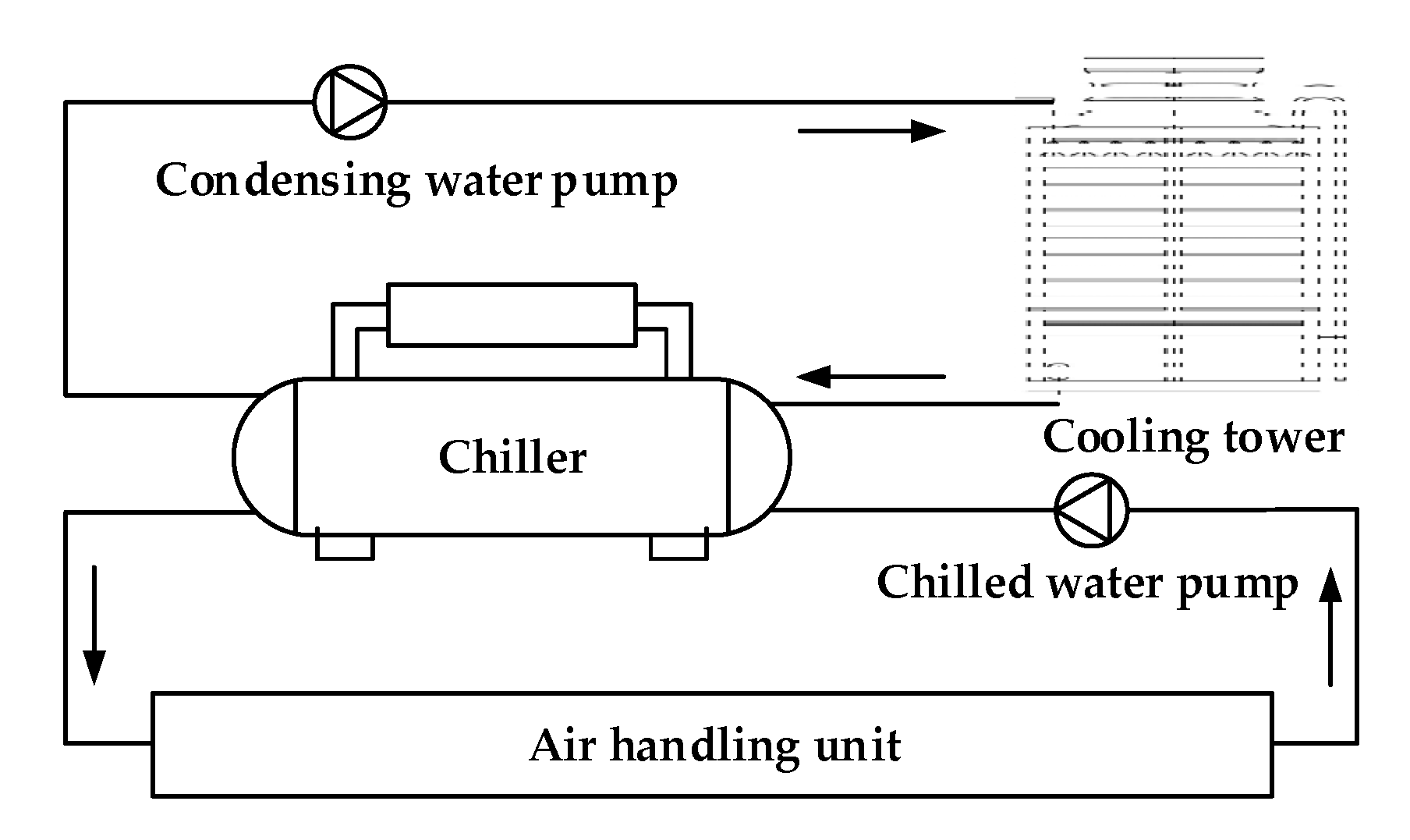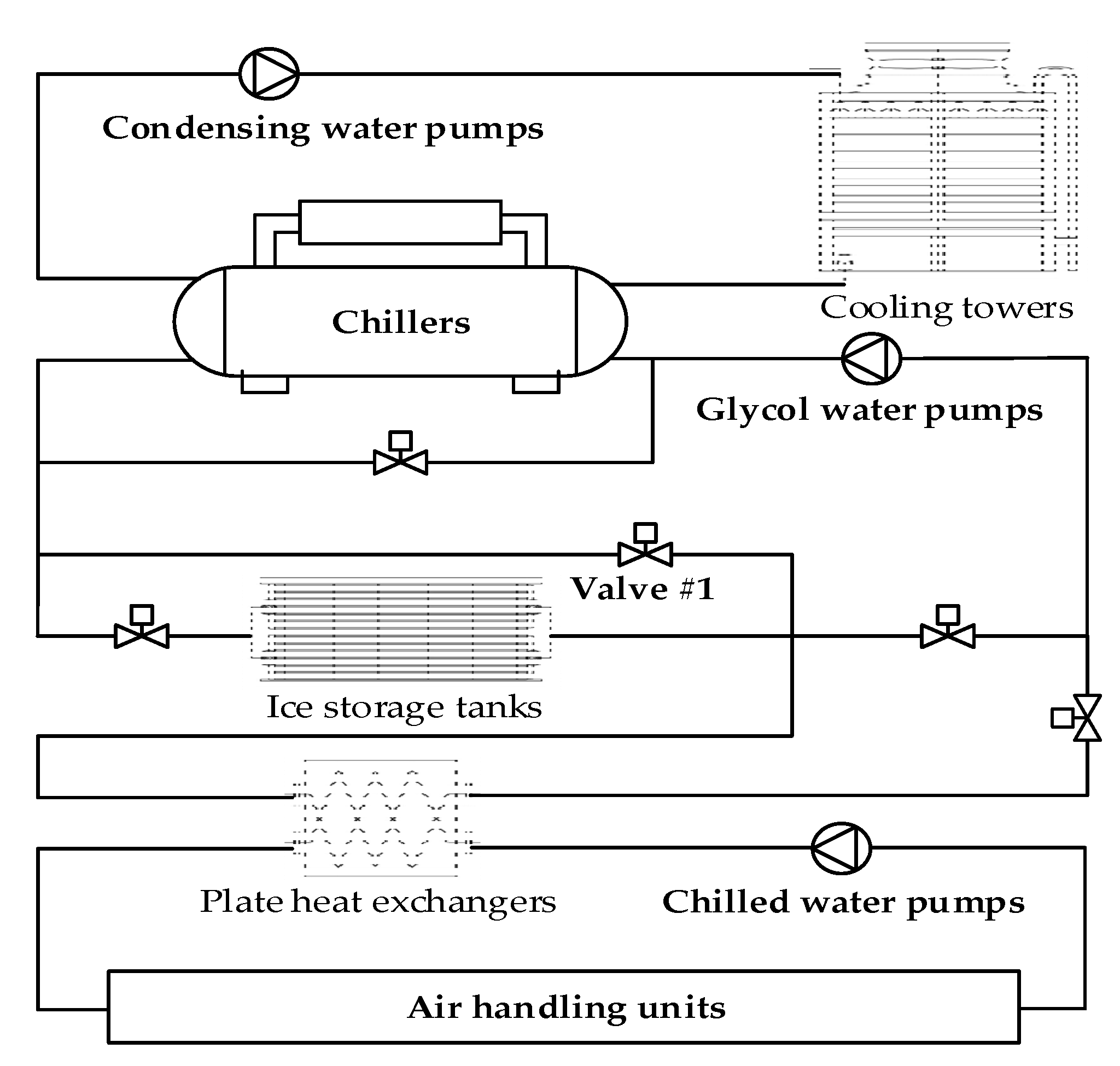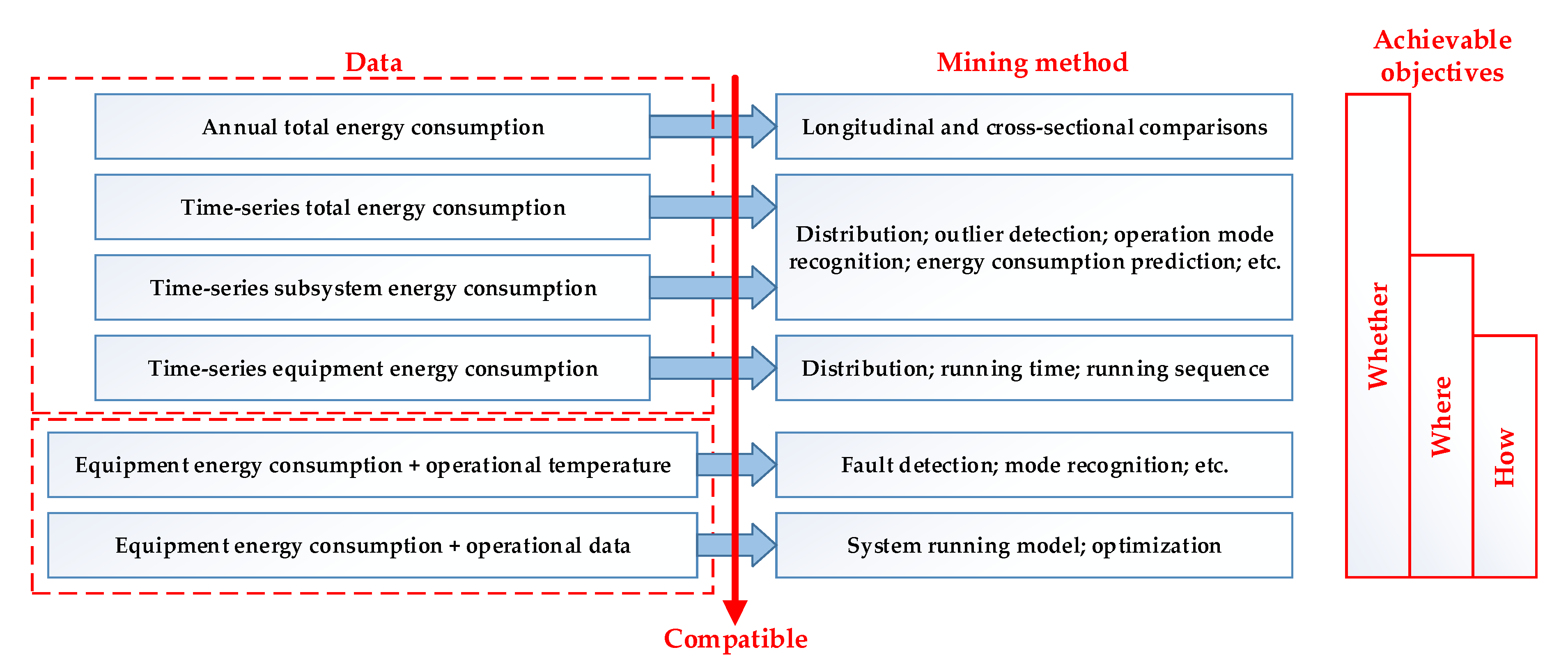Systematic Method for the Energy-Saving Potential Calculation of Air-Conditioning Systems via Data Mining. Part I: Methodology
Abstract
:1. Introduction
2. Introduction to the Systematic Method
2.1. Framework of the Method
2.2. Data Collection
2.3. Data Preprocessing
- Missing data preprocessing. Accidents occurring during data monitoring, transfer, and storage can cause missing data, leading to deficient information on the system running status, thereby impacting the accuracy of the analysis results. There are several ways to deal with missing data, depending on their importance and quantity. At some time-points, the data of some key parameters, such as energy consumption and/or output temperature of the chiller, are missing during the collection, especially for a long period. Subsequently, we need to perform the list-wise deletion to preprocess the dataset, which means that all the data at the time points have to be removed from the following analysis. Alternatively, to ensure data continuity and isometry, we can set the weight of variables at the time points to zero. For analysis that does not require time-series conceptualization, for example, regression analysis of energy consumption and flow rate for pumps, only the data that pair with the missing one need to be excluded, which can be named pairwise deletion.
- Data cleaning. In terms of the data from an air-conditioning system, the data cleaning step mainly covers three aspects: (1) Duplicate data cleaning. Duplicate data may exist when data are gathered from different platforms. Duplicated data should be removed from the dataset to reduce computing costs and avoid data confusion. (2) Halt data cleaning. When an air-conditioning system halts, the collected energy consumption should be zero. Nevertheless, other parameters, such as chilled water temperature, are recorded in the dataset, which can cause confusion when we look into the trends of these parameters. In addition, for the statistics of the energy consumption data (see Section 2.4), zero data strongly influences the data distribution, and thus cannot represent the running conditions of the system. Therefore, halt data should be excluded. (3) Conflict of data cleaning. Sometimes, owing to the influences of noise and sensor failure, several related parameters could exhibit conflicts with each other. For instance, a conflict occurs when the water temperature supply is higher than the return water for a running chiller. Additional underlying conflicts against the normal principles of a running air-conditioning system may also exist. For example, there is a large disparity between the measured cooling load and the theoretical one (calculated based on the chilled water flow rate and the temperature difference between the return and supply water). In such cases, all the data at the corresponding time points with conflicts should be deleted for the following analysis.
- Data extension. When preprocessing the raw data, we need to add several columns to the dataset based on the calculation and summary of raw data variables. For instance, by calculating the difference between the chilled water supply and return, we can add a new variable to the dataset. Apart from adding variables by calculation, labeling of the data can also be appended. For example, after the recognition of the system operation mode (see Section 2.5), the labeling of the operation mode can be added to the dataset.
2.4. Recognition of Variable-Speed Equipment
2.5. Recognition of System Operation Mode
2.6. Regression Analysis of Energy-Consumption Data
2.7. Constraints Analysis of System Operation
2.8. Energy-Saving Potential Analysis
3. Case Study
3.1. Data Collection and Preprocessing
3.2. Recognition of Variable-Speed Chillers and Pumps
3.3. Recognition of System-Operation Mode
3.4. Regression and Constraint Analysis
- (1)
- The cooling capacity supplied by the chiller plant room must be sufficient to meet the cooling load of the case system;
- (2)
- The cooling capacity supplied by chillers should not exceed the maximum cooling capacity of chillers;
- (3)
- The sum of the accumulation of the cooling capacity in the ice storage tanks and the current remaining cooling capacity should not exceed their maximum accumulation of cooling capacity;
- (4)
- The accumulation of cooling capacity in the ice storage tanks should be equal to the cooling capacity supplied by the chillers during ice build, and cannot exceed the maximum cooling storage speed;
- (5)
- The cooling release of the ice storage tanks should not exceed the remaining cooling capacity as well as the maximum cooling release speed.
3.5. Energy/Cost Saving Potential Analysis with Optimization Algorithms
4. Discussion
4.1. Comparison with the Conventional Method
4.1.1. Consumed Resources
4.1.2. Data in Use
4.1.3. Technical Details
4.1.4. Main Characteristics
4.1.5. Summary
4.2. Influence of Data Completeness
4.3. Limitations and Future Outlook
- As presented in Section 4.1, It has been a common practice to illustrate the advantages and disadvantages of a newly proposed framework in a qualitative way, especially for new systematic methods [27,28,29]. Nevertheless, in order to make a more straightforward comparison, there are three future directions to work on: (1) to apply the systematic method to a large number of case studies to have an overall range of the performance evaluation and then to compare them with the performance range of the conventional OTI method; (2) to apply both methods in one case study simultaneously and to directly compare the performance of two methods; and (3) given the complementary features of the two methods, to apply both methods together in one case study and to obtain more comprehensive diagnosis results. We encourage more research to target the aforementioned three directions in order to demonstrate in a straightforward way the advantages and disadvantages of the proposed method, and to investigate optimal approaches to coordinate it to traditional methods.
- The main objective of this study has been to calculate the energy saving potential by optimizing the system operating parameters, when the primary cooling load demand can be met. Therefore, indoor environmental quality (IEQ, including but not limited to air change rate and thermal comfort) is not considered yet. We believe that other than focusing on energy consumption, further research can also attempt to apply the proposed method to consider the optimization of IEQ.
5. Conclusions
Author Contributions
Funding
Institutional Review Board Statement
Informed Consent Statement
Data Availability Statement
Acknowledgments
Conflicts of Interest
References
- Lam, T.N.T.; Wan, K.K.W.; Wong, S.L.; Lam, J.C. Impact of climate change on commercial sector air conditioning energy consumption in subtropical Hong Kong. Appl. Energy 2010, 87, 2321–2327. [Google Scholar] [CrossRef]
- Li, C.; Zhou, J.; Cao, Y.; Zhong, J.; Liu, Y.; Kang, C.; Tan, Y. Interaction between urban microclimate and electric air-conditioning energy consumption during high temperature season. Appl. Energy 2014, 117, 149–156. [Google Scholar] [CrossRef]
- Ginestet, S.; Marchio, D.; Morisot, O. Improvement of buildings energy efficiency: Comparison, operability and results of commissioning tools. Energy Convers. Manag. 2013, 76, 368–376. [Google Scholar] [CrossRef]
- Fayyad, U.M.; Piatetsky-Shapiro, G.; Smyth, P.; Uthurusamy, R. Advances in Knowledge Discovery and Data Mining; AAAI Press: Cambridge, MA, USA, 1996. [Google Scholar]
- Zhao, Y.; Zhang, C.; Zhang, Y.; Wang, Z.; Li, J. A review of data mining technologies in building energy systems: Load prediction, pattern identification, fault detection and diagnosis. Energy Built Environ. 2020, 1, 149–164. [Google Scholar] [CrossRef]
- Kim, H.; Stumpf, A.; Kim, W. Analysis of an energy efficient building design through data mining approach. Autom. Constr. 2011, 20, 37–43. [Google Scholar] [CrossRef]
- Ahmed, A.; Korres, N.E.; Ploennigs, J.; Elhadi, H.; Menzel, K. Mining building performance data for energy-efficient operation. Adv. Eng. Inform. 2011, 25, 341–354. [Google Scholar] [CrossRef]
- Wang, Z.; Han, N.; Wang, Y. Studies on neural network modeling for air conditioning system by using data mining with association analysis. In Proceedings of the 2011 International Conference on Internet Computing and Information Services, ICICIS 2011, Hong Kong, China, 17–18 September 2011; pp. 423–427. [Google Scholar]
- Hou, Z.; Lian, Z.; Yao, Y.; Yuan, X. Data mining based sensor fault diagnosis and validation for building air conditioning system. Energy Convers. Manag. 2006, 47, 2479–2490. [Google Scholar] [CrossRef]
- Rakhshani, E.; Sariri, I.; Rouzbehi, K. Application of data mining on fault detection and prediction in boiler of power plant using artificial neural network. In Proceedings of the POWERENG 2009—2nd International Conference on Power Engineering, Energy and Electrical Drives Proceedings, Lisbon, Portugal, 18–20 March 2009; pp. 473–478. [Google Scholar]
- Du, Z.; Fan, B.; Jin, X.; Chi, J. Fault detection and diagnosis for buildings and HVAC systems using combined neural networks and subtractive clustering analysis. Build. Environ. 2014, 73, 1–11. [Google Scholar] [CrossRef]
- Liu, D.; Chen, Q.; Mori, K.; Kida, Y. A method for detecting abnormal electricity energy consumption in buildings. J. Comput. Inf. Syst. 2010, 6, 4887–4896. [Google Scholar]
- Li, X.; Bowers, C.P.; Schnier, T. Classification of energy consumption in buildings with outlier detection. IEEE Trans. Ind. Electron. 2010, 57, 3639–3644. [Google Scholar] [CrossRef]
- Seem, J.E. Pattern recognition algorithm for determining days of the week with similar energy consumption profiles. Energy Build. 2005, 37, 127–139. [Google Scholar] [CrossRef]
- Bagnasco, A.; Fresi, F.; Saviozzi, M.; Silvestro, F.; Vinci, A. Electrical consumption forecasting in hospital facilities: An application case. Energy Build. 2015, 103, 261–270. [Google Scholar] [CrossRef]
- Zhao, D.; Zhong, M.; Zhang, X.; Su, X. Energy consumption predicting model of VRV (Variable refrigerant volume) system in office buildings based on data mining. Energy 2016, 102, 660–668. [Google Scholar] [CrossRef]
- Fan, C.; Xiao, F.; Zhao, Y. A short-term building cooling load prediction method using deep learning algorithms. Appl. Energy 2017, 195, 222–233. [Google Scholar] [CrossRef]
- Naji, S.; Keivani, A.; Shamshirband, S.; Alengaram, U.J.; Jumaat, M.Z.; Mansor, Z.; Lee, M. Estimating building energy consumption using extreme learning machine method. Energy 2016, 97, 506–516. [Google Scholar] [CrossRef]
- Amber, K.P.; Ahmad, R.; Aslam, M.W.; Kousar, A.; Usman, M.; Khan, M.S. Intelligent techniques for forecasting electricity consumption of buildings. Energy 2018, 157, 886–893. [Google Scholar] [CrossRef]
- Li, G.; Hu, Y.; Chen, H.; Li, H.; Hu, M.; Guo, Y.; Liu, J.; Sun, S.; Sun, M. Data partitioning and association mining for identifying VRF energy consumption patterns under various part loads and refrigerant charge conditions. Appl. Energy 2017, 185, 846–861. [Google Scholar] [CrossRef]
- Qiu, S.; Feng, F.; Li, Z.; Yang, G.; Xu, P.; Li, Z. Data mining based framework to identify rule based operation strategies for buildings with power metering system. Build. Simul. 2019, 12, 195–205. [Google Scholar] [CrossRef]
- Fan, C.; Xiao, F.; Song, M.; Wang, J. A graph mining-based methodology for discovering and visualizing high-level knowledge for building energy management. Appl. Energy 2019, 251, 113395. [Google Scholar] [CrossRef]
- Zhao, Y.; Li, T.; Zhang, X.; Zhang, C. Artificial intelligence-based fault detection and diagnosis methods for building energy systems: Advantages, challenges and the future. Renew. Sustain. Energy Rev. 2019, 109, 85–101. [Google Scholar] [CrossRef]
- Karami, M.; Wang, L. Fault detection and diagnosis for nonlinear systems: A new adaptive Gaussian mixture modeling approach. Energy Build. 2018, 166, 477–488. [Google Scholar] [CrossRef]
- Yan, K.; Ma, L.; Dai, Y.; Shen, W.; Ji, Z.; Xie, D. Cost-sensitive and sequential feature selection for chiller fault detection and diagnosis. Int. J. Refrig. 2018, 86, 401–409. [Google Scholar] [CrossRef]
- Guo, Y.; Tan, Z.; Chen, H.; Li, G.; Wang, J.; Huang, R.; Liu, J.; Ahmad, T. Deep learning-based fault diagnosis of variable refrigerant flow air-conditioning system for building energy saving. Appl. Energy 2018, 225, 732–745. [Google Scholar] [CrossRef]
- Ashouri, M.; Haghighat, F.; Fung, B.C.M.; Lazrak, A.; Yoshino, H. Development of building energy saving advisory: A data mining approach. Energy Build. 2018, 172, 139–151. [Google Scholar] [CrossRef]
- Fung, B.C.M.; Haghighat, F. Extracting knowledge from building-related data—A data mining framework. Build. Simul. 2013, 6, 207–222. [Google Scholar]
- Xiao, F.; Fan, C. Data mining in building automation system for improving building operational performance. Energy Build. 2014, 75, 109–118. [Google Scholar] [CrossRef]
- Ma, R.; Yang, S.; Wang, X.; Wang, X.; Shan, M.; Yu, N.; Yang, X. Systematic method for the energy-saving potential calculation of air conditioning systems via data mining. Part Ⅱ: A detailed case study. Energies, 2021; 14, 86. [Google Scholar] [CrossRef]
- Ma, R.; Wang, X.; Shan, M.; Yu, N.; Yang, S. Recognition of variable-speed equipment in an air-conditioning system using numerical analysis of energy-consumption data. Energies 2020, 13, 4975. [Google Scholar] [CrossRef]
- Yan, R.; Ma, Z.; Zhao, Y.; Kokogiannakis, G. A decision tree based data-driven diagnostic strategy for air handling units. Energy Build. 2016, 133, 37–45. [Google Scholar] [CrossRef]
- Han, J.; Kamber, M.; Pei, J. Data Mining: Concepts and Techniques, 3rd ed.; Elsevier Inc.: Waltham, MA, USA, 2012; ISBN 9780123814791. [Google Scholar]
- Zhang, G.; Chen, L. Opmization of energy consumption in chilled plant. Fluid Mach. 2012, 40, 75–80. [Google Scholar]
- Ma, R. The Study of Energy Efficiency Diagnosis Methodology for Air-Conditioning Systems with the Actual Operating Data. Ph.D. Thesis, Southwest Jiaotong University, Chengdu, China, 2014. [Google Scholar]




| Objects | Parameters |
|---|---|
| Outdoor air | Temperature |
| Humidity (or relative humidity) | |
| Chiller | Temperature of (supply/return) chilled water |
| Temperature of (supply/return) condensing water | |
| Electrical energy consumption | |
| Chilled water flow | |
| Condensing water flow | |
| Chilled water pump | Water flow |
| Electrical energy consumption | |
| Condensing water pump | Water flow |
| Electrical energy consumption | |
| Plant | Temperature of (supply/return) chilled water in main pipe |
| Temperature of (supply/return) condensing water in main pipe | |
| Total plant electrical energy consumption | |
| Opening of major valve (For change of operating modes) | |
| Cooling tower | Temperature of (supply/return) working fluid |
| Water flow | |
| Electrical energy consumption | |
| Air handling unit | Temperature of (supply/return) air |
| Air flow | |
| Electrical energy consumption |
| Operating Modes | Codes | Recognizing Rules 1 |
|---|---|---|
| Shutdown | M0 | Rule 2 & Rule 4 & Rule 6 & Rule 8 |
| Ice build | M1 | Rule 1 |
| Cooling by chiller(s) only | M2 | Rule 2 & Rule 3 |
| Cooling by ice only | M3 | Rule 2 & Rule 4 & Rule 6 & Rule 7 |
| Cooling by ice with chiller(s) | M4 | Rule 2 & Rule 4 & Rule 5 |
| Day | Actual Costs (CNY) | Optimal Costs (CNY) | ||
|---|---|---|---|---|
| PSO | GA | ACO | ||
| 1–10 | 72,839.5 | 59,024.7 | 63,326.8 | 60,748.6 |
| 11–20 | 65,922.0 | 53,591.7 | 63,711.4 | 57,737.5 |
| 21–30 | 66,967.1 | 50,673.4 | 61,151.6 | 53,671.9 |
| 31–40 | 58,514.0 | 46,051.8 | 49,331.2 | 47,603.5 |
| 41–50 | 74,628.9 | 53,489.5 | 58,802.9 | 56,950.5 |
| 51–59 | 70,631.7 | 50,734.6 | 59,945.4 | 54,075.9 |
| Total | 400,467.6 | 307,213.5 | 350,321.7 | 324,513.9 |
| Item | Proposed Systematic Method | Conventional OTI Method |
|---|---|---|
| Orientation | Data-oriented | Problem-oriented |
| Basic principle | Energy saving potential optimization calculation based on daily operation data | Energy saving diagnosis by field investigation and test |
| Main pathway | Optimizing operation strategies based on existing equipment and systems | Troubleshooting existing equipment or retrofitting equipment |
| Consumed resources | Low consuming of time and human resources, but high demand of computational resources | Time- and researcher-consuming but low level of computational demands |
| Data in use | Strong dependence on data monitoring platform; high-level demand of data scope and quantity; better data synchronization. | Strong dependence on field measurement; potential issues in data synchronization |
| Technical details | Reasonable solutions owing to a broader picture of system running constraints | Potential issues in realizing proposed solutions |
| Main characteristics | Less flexibility, especially with respect to individual component; remote control and online diagnosis | Wider applicability in both equipment and systems; inevitable field presence |
Publisher’s Note: MDPI stays neutral with regard to jurisdictional claims in published maps and institutional affiliations. |
© 2020 by the authors. Licensee MDPI, Basel, Switzerland. This article is an open access article distributed under the terms and conditions of the Creative Commons Attribution (CC BY) license (http://creativecommons.org/licenses/by/4.0/).
Share and Cite
Ma, R.; Yang, S.; Wang, X.; Wang, X.-C.; Shan, M.; Yu, N.; Yang, X. Systematic Method for the Energy-Saving Potential Calculation of Air-Conditioning Systems via Data Mining. Part I: Methodology. Energies 2021, 14, 81. https://doi.org/10.3390/en14010081
Ma R, Yang S, Wang X, Wang X-C, Shan M, Yu N, Yang X. Systematic Method for the Energy-Saving Potential Calculation of Air-Conditioning Systems via Data Mining. Part I: Methodology. Energies. 2021; 14(1):81. https://doi.org/10.3390/en14010081
Chicago/Turabian StyleMa, Rongjiang, Shen Yang, Xianlin Wang, Xi-Cheng Wang, Ming Shan, Nanyang Yu, and Xudong Yang. 2021. "Systematic Method for the Energy-Saving Potential Calculation of Air-Conditioning Systems via Data Mining. Part I: Methodology" Energies 14, no. 1: 81. https://doi.org/10.3390/en14010081
APA StyleMa, R., Yang, S., Wang, X., Wang, X.-C., Shan, M., Yu, N., & Yang, X. (2021). Systematic Method for the Energy-Saving Potential Calculation of Air-Conditioning Systems via Data Mining. Part I: Methodology. Energies, 14(1), 81. https://doi.org/10.3390/en14010081






